New camera!
I finally bit the bullet.
I got a digital SLR camera.
Nikon D90 with Tamron 18-270mm lens.
Thank you all who’ve donated to support this site. Your donations helped cover almost half the cost. You guys rock!
This is actually my second SLR camera. For a long time I used to shoot on Minolta Maxxum 5 film camera. So why a new one?
Bye bye film
Shooting on film is sort of like Christmas. You never know what you’ll get. One of the last straws for me was coming back from hiking the John Muir Trail in California, taking a bag of rolls to the print shop, eagerly awaiting the amazing nature photos I thought I had taken, and finding out that most of the photos were mediocre at best. The exposure was off, they were either too light or too dark to properly capture the beautiful alpine lakes and sawtooth peaks.
Plus shooting on film can get quite pricey. So, I ended up retiring the Minolta sometimes in 2008 and bough my first-ever digital camera, a point-and-shoot Canon Powershot SD1100. I got that camera just in time for the Trans-Siberian adventure. It worked out great. Point and shoot cameras are great for traveling – they are small, light, and last for a long time on a single charge.
Isn’t this just an expensive toy?
However, they suffer from several limitations. The beauty of an SLR (meaning single lens reflex) camera is that you look directly through the lens while composing the photo. This is because the camera contains a mirror in front of what used to be film, and is now the digital counterpart called CCD (charge-coupled device, sensor which detect the photons hitting it). While composing the photo, the CCD is behind the mirror, and the light is reflected into the eyepiece. When you press the shutter button, the mirror rapidly lifts up, exposing the CCD. This is also why the viewfinder in SLRs goes black while the photo is being taken – the mirror is lifted up.
Why is this important? For one, you can attach different lenses to the camera. In addition, you can attach various filters to the front of the lens. One of the most popular filters, circular polarizer, is absolutely amazing. It works like your polarized sunglasses and increases the contrast of the image. This filter can be rotated to alter the amount of polarization. You look through the viewfinder onto a pale sky, rotate the filter, and all of the sudden the pale sky becomes vibrant blue with clouds appearing in the image seemingly out of nowhere.
SLRs also let you control the aperture setting. To take a photo that is neither too dark nor too light, you need to expose the CCD with just the right amount of light. The camera automatically calculates the amount of light and opens the shutter for just the right number of milliseconds. However, shutter speed is not the only factor affecting exposure. The amount of light reaching the CCD is also controlled by how wide the shutter opens. Think of the shutter as the pupil in your eye. If it’s bright out, the pupils open only slightly. If it’s dark, they are wide open. Camera’s shutter works the same way. An SLR camera allows you to not only control the shutter speed but also the aperture – the size of the opening. The aperture setting has an interesting effect on the final photo. The wider the shutter opens, the blurrier features in front and behind the object you are focusing on get. This allows you to take “artsy” photos, where you separate the subject (such as a tasty Slovak dish) from the distracting background.
Noise noise everywhere
All these features are nice. But the main reason I went for a new camera is simpler. The light in my kitchen is horrible. It’s way too dark, and the Canon Powershot simply sucks in low light situation.
So that’s why I went for Nikon D90. Bunch of camera reviews I’ve found online said that although most modern DSLRs work great in well-lit situation, Nikon D90 really shines when it comes to lack of light. It really seems to be true! I did a little experiment: check out the photos below.
Films came in different ISO settings. Lower the ISO, the better the quality of the image – more vivid the colors, less noise. However, lower ISO film also needed to be exposed longer than one with higher ISO number. So while some photos could be shot no-problem hand-holding the camera at ISO 400, taking the same photo with ISO 100 film required the camera to be put on a tripod.
CCDs work on exactly the same principle. The Canon can shoot up to ISO 1600, but I’ve found that anything higher than ISO 400 is simply not acceptable. The photo on the left was shot with the Canon at ISO 800 (not even the highest setting). Click on it and see how the black body of my old Maxxum 5 is not black at all. It’s full of alternating gray and red pixels. This is noise. The photo on the right is from the Nikon. It was shot at whooping ISO 3200. Yet, the camera body is nicely black, almost totally noise free. Quite impressive!
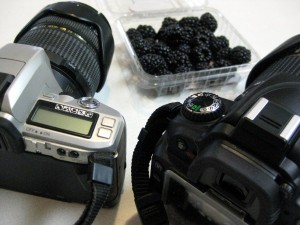
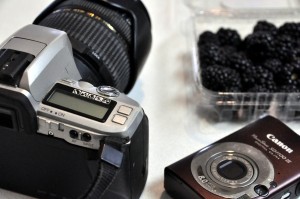
Comparison in noise levels: image from Canon Powershot shot at ISO 800 on the left, and one from Nikon D90 shot at ISO 3200 on the right.
Lens and such
With the camera, I ended up getting the digital version of the 28mm-300mm Tamron lens I used with my old SLR: Tamron 18-270mm. I love these lenses! It’s a great lens for someone (like me) who like traveling or going hiking. You get landscape and close up, all in one lens. No need to lug around bunch of different lenses, or risk getting the inside of the camera dirty changing lenses in bad weather. The photos below show you the range of images you can get with this lens. Both photos were shot from the same spot.
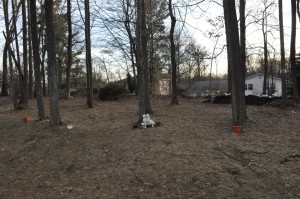

Both of these shots were taken from the same place. Pretty impressive zoom!
You can also do some pretty nifty things with an SLR, like take long exposure photos. There is too much light pollution here outside of D.C. where I live to take star photos. But I tried a long exposure photo on my neighbor’s house. The photo below was taken just before midnight, with it being almost pitch black outside. It’s a 30 second exposure. It’s quite amazing how colors still come out right, even the sky is blue!
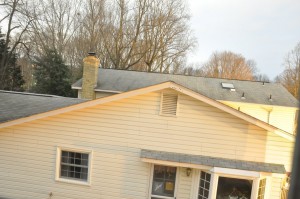
Just playing with long exposure. This photo was taken in the middle of the night, while it was pitch dark outside. 30 second exposure.
I don’t plan to retire the Canon completely. The camera has been a trooper. It so often gets covered in flour and oil and still keeps on trucking. I’ll continue using it while cooking, or at least while preparing “dirty” dishes. But for the final photos, I’ll use the Nikon. I’ll also use it to shoot images for the upcoming Slovak Cooking cookbook. But more on that later…
And if you can, please donate to support slovakcooking.com. Your donation will help cover the second half of the cost of the camera plus things like site maintenance. Ďakujem!
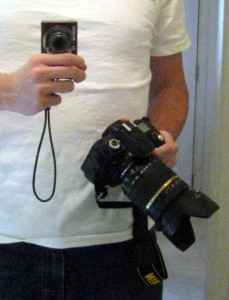
Congratulations and hope you have lots of fun with your new toy…ummm camera! I just bought a Nikon D3100 myself and have been enjoying the new level of control immensely. I was divied between the D90 and D3100 and went with the latter because of the video capability.
We’ve come a long way from the Brownie Camera purchased from the local drugstore! (This is before your time.) Good luck with the new camera.
Congratulations! You have made an excellent choice, and your Nikon body will be with you for a long time. They are built to take a beating. Hopefully, Nikon will offer more compatible lenses in the near future. My “normal” lens is a Micro Nikkor 105mm (yes, I’ve been a devoted Nikon user for many years) which allows me to get extremely good close-up focus while still functioning quite well for most general situations. Do you use any graphics software? Even Adobe Photoshop Elements is a huge help for cleaning up unwanted “stuff.” Another great advantage of your new camera is that you can easily carry extra batteries and extra memory cards to further extend the number of images that you capture in one session. I know you will really enjoy taking lots of pictures.
Thanks B.J., Yup, I am quite familiar with photo retouching. I use Gimp, http://www.gimp.org/, which is basically the free version of Photoshop. Folks who are familiar with Photoshop will probably disagree with me. But never having actually used Adobe Photoshop, I’ve found gimp to have all the features I need. I basically use it adjust “levels”. Photos from the Powershot come out looking very foggy. I think part of the reason is that the lens is too schmutzed up with various kitchen greases. I have tried cleaning it few times and it seems to help – for a day or two. Adjusting levels results in the fog going away, and photo gaining more contrast. It also affects the color balance, often for better, but not always. So sometimes it’s a tedious manual process getting the photo looking right. It’s especially bad when photos are shot at night under the fluorescent lights in the kitchen. I have been playing with the white balance setting on the Canon but it doesn’t always work as expected.
A very educational column on cameras, I enjoyed it very much; even as I enjoy your Slovak cooking articles. I can really both see and feel your passion for the subject.
A donation to follow, thanks for your efforts.
Our groups website is CGSI.org, a Czech/Slovak genealogy organization, if you’d care to look us up.
As long as you have access to some kind of photo-enhancement software, and as long as it works for you–that’s all that matters. Does Gimp also allow you to adjust a curve ramp (in addition to adjusting levels) or to adjust color balance and saturation? Because I am involved in creating digital art, I do use Photoshop a lot, but it has a steep learning curve and probably has far too many fussy options for most routine photo corrections. As far as your lens fogging up, for your new camera you might like to consider protecting the lens with a screw-on filter. I use a Haze-1, but there are others and they are not expensive. It is so much better to just remove and clean a messy filter than to try to clean the lens itself. I’m looking forward to seeing what your new camera produces.
Yup. As far as I can tell, Gimp has all the functionality of Photoshop, except that the menu layout is different. You should give it a try. It’s awesome. And free. 🙂
I’ve got the UV filter on this lens. I also got CPL and FDL. Somewhere down the line I’ll get graduated neutral density (for taking nature shots of snow covered peaks), but those are quite pricey.
What kind of digital art do you create? Do you have a portfolio online?
My digital art uses composites of my photo-images in a variety of ways–I rearrange, recolor, and reconstruct images in a way that is like painting with the computer. (Most of my Facebook avatars are rather simple examples of original art created with Photoshop.) I earned a degree in photography many years ago, but didn’t do much with it because I was working in a high-stress production job that took all of my attention and energy, and also had difficulties finding space for a darkroom because rentals in the Chicago area have always been quite expensive. Now that I am retired, and photography has made a huge change from film to digital, I am once again continuing to work in my own creative direction. I have been taking advanced Photoshop courses at a local community college to catch up with the digital aspects, and have dreams of working on a master’s degree in photography (but time is running out on me).
I don’t have an online portfolio, although I have been working on the development of my own website for a while. Thanks for asking. This project is somewhat difficult for me to continue with because I tend to be overly protective of my privacy. I do exhibit prints locally when I have the opportunity.